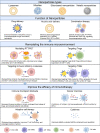Modulating the tumor immune microenvironment with nanoparticles: A sword for improving the efficiency of ovarian cancer immunotherapy
- PMID: 36532066
- PMCID: PMC9751906
- DOI: 10.3389/fimmu.2022.1057850
Modulating the tumor immune microenvironment with nanoparticles: A sword for improving the efficiency of ovarian cancer immunotherapy
Abstract
With encouraging antitumor effects, immunotherapy represented by immune checkpoint blockade has developed into a mainstream cancer therapeutic modality. However, only a minority of ovarian cancer (OC) patients could benefit from immunotherapy. The main reason is that most OC harbor a suppressive tumor immune microenvironment (TIME). Emerging studies suggest that M2 tumor-associated macrophages (TAMs), T regulatory cells (Tregs), myeloid-derived suppressor cells (MDSCs), and cancer-associated fibroblasts (CAFs) are enriched in OC. Thus, reversing the suppressive TIME is considered an ideal candidate for improving the efficiency of immunotherapy. Nanoparticles encapsulating immunoregulatory agents can regulate immunocytes and improve the TIME to boost the antitumor immune response. In addition, some nanoparticle-mediated photodynamic and photothermal therapy can directly kill tumor cells and induce tumor immunogenic cell death to activate antigen-presenting cells and promote T cell infiltration. These advantages make nanoparticles promising candidates for modulating the TIME and improving OC immunotherapy. In this review, we analyzed the composition and function of the TIME in OC and summarized the current clinical progress of OC immunotherapy. Then, we expounded on the promising advances in nanomaterial-mediated immunotherapy for modulating the TIME in OC. Finally, we discussed the obstacles and challenges in the clinical translation of this novel combination treatment regimen. We believe this resourceful strategy will open the door to effective immunotherapy of OC and benefit numerous patients.
Keywords: drug delivery system; immunotherapy; nanoparticles; ovarian cancer; tumor immune microenvironment.
Copyright © 2022 Xu, Liu, Huang, Jing and Liu.
Conflict of interest statement
The authors declare that the research was conducted in the absence of any commercial or financial relationships that could be construed as a potential conflict of interest.
Figures


Similar articles
-
Targeting the immune microenvironment for ovarian cancer therapy.Front Immunol. 2023 Dec 18;14:1328651. doi: 10.3389/fimmu.2023.1328651. eCollection 2023. Front Immunol. 2023. PMID: 38164130 Free PMC article. Review.
-
A new strategy for the treatment of advanced ovarian cancer: utilizing nanotechnology to regulate the tumor microenvironment.Front Immunol. 2025 Feb 12;16:1542326. doi: 10.3389/fimmu.2025.1542326. eCollection 2025. Front Immunol. 2025. PMID: 40013141 Free PMC article. Review.
-
Programmed death-1 pathway blockade produces a synergistic antitumor effect: combined application in ovarian cancer.J Gynecol Oncol. 2017 Sep;28(5):e64. doi: 10.3802/jgo.2017.28.e64. Epub 2017 Jun 5. J Gynecol Oncol. 2017. PMID: 28657225 Free PMC article. Review.
-
Charge-switchable nanoparticles enhance Cancer immunotherapy based on mitochondrial dynamic regulation and immunogenic cell death induction.J Control Release. 2021 Jul 10;335:320-332. doi: 10.1016/j.jconrel.2021.05.036. Epub 2021 May 29. J Control Release. 2021. PMID: 34062192
-
The Complex Tumor Microenvironment in Ovarian Cancer: Therapeutic Challenges and Opportunities.Curr Oncol. 2024 Jul 1;31(7):3826-3844. doi: 10.3390/curroncol31070283. Curr Oncol. 2024. PMID: 39057155 Free PMC article. Review.
Cited by
-
Photothermally sensitive gold nanocage augments the antitumor efficiency of immune checkpoint blockade in immune "cold" tumors.Front Immunol. 2023 Oct 24;14:1279221. doi: 10.3389/fimmu.2023.1279221. eCollection 2023. Front Immunol. 2023. PMID: 37942337 Free PMC article.
-
B-Myb deficiency boosts bortezomib-induced immunogenic cell death in colorectal cancer.Sci Rep. 2024 Apr 2;14(1):7733. doi: 10.1038/s41598-024-58424-w. Sci Rep. 2024. PMID: 38565963 Free PMC article.
-
Recent advances in understanding the immune microenvironment in ovarian cancer.Front Immunol. 2024 Jun 5;15:1412328. doi: 10.3389/fimmu.2024.1412328. eCollection 2024. Front Immunol. 2024. PMID: 38903506 Free PMC article. Review.
-
Drug Delivery System Targeting Cancer-Associated Fibroblast for Improving Immunotherapy.Int J Nanomedicine. 2025 Jan 11;20:483-503. doi: 10.2147/IJN.S500591. eCollection 2025. Int J Nanomedicine. 2025. PMID: 39816375 Free PMC article. Review.
-
Revolutionizing cancer treatment: nanotechnology-enabled photodynamic therapy and immunotherapy with advanced photosensitizers.Front Immunol. 2023 Oct 4;14:1219785. doi: 10.3389/fimmu.2023.1219785. eCollection 2023. Front Immunol. 2023. PMID: 37860012 Free PMC article. Review.
References
Publication types
MeSH terms
LinkOut - more resources
Full Text Sources
Medical

